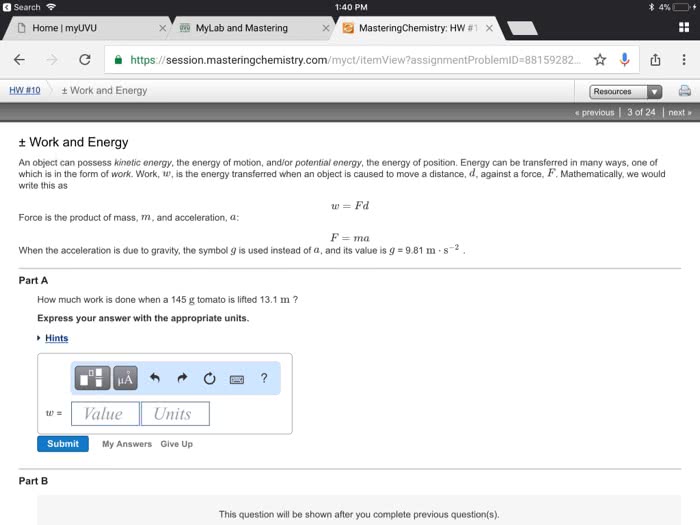CHEM 1R03 Lecture 1: SPH3U,T3L3,GPE
27 views1 pages
28 Nov 2017
School
Department
Course
Professor
Document Summary
The work done (against gravity) on an object equals the potential energy of the object at some height above the initial position. W = f d, where w = e g. E g = f d, where f = mg. E g = mgd, where d = h. Therefore, we can use this formula to determine the gravitational potential energy possessed by an object. E g = mgh m is the mass of the object in kg g is acceleration due to gravity in m/s2 or n/kg h is height in meters (m) As we lift something higher, it will possess more potential energy. Galileo wants to drop a 1. 5kg watermelon off of a 10m high roof. A 2. 35g penny is dropped from the observation deck of the cn tower.
Get access
Grade+20% off
$8 USD/m$10 USD/m
Billed $96 USD annually

Homework Help
Study Guides
Textbook Solutions
Class Notes
Textbook Notes
Booster Class
40 Verified Answers
Class+
$8 USD/m
Billed $96 USD annually

Homework Help
Study Guides
Textbook Solutions
Class Notes
Textbook Notes
Booster Class
30 Verified Answers
Related textbook solutions
Chemistry: Structure and Properties
2 Edition,
Tro
ISBN: 9780134293936
Basic Chemistry
5 Edition,
Timberlake
ISBN: 9780134138046
Principles of Chemistry Molecular Approach
4th Edition,
Tro
ISBN: 9780134112831
Chemistry: Structure and Properties
2nd Edition,
Tro
ISBN: 9780134293936
Principles of Chemistry Molecular Approach
3rd Edition, 2014
Tro
ISBN: 9780321971944
Chemistry: A Molecular Approach
3rd Edition,
Tro
ISBN: 9780321809247
Chemistry: A Molecular Approach
5th Edition,
Tro
ISBN: 9780134874371
Principles of Chemistry: A Molecular Approach
4th Edition,
Tro
ISBN: 9780134895741
Chemistry: The Central Science
14th Edition, 2017
Brown
ISBN: 9780134414232
